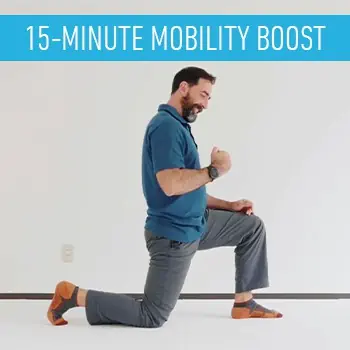You don’t need to read another fear-mongering article about how sitting is bad for you. Chances are, if you sit at a desk all day (like most of us), then you already know that it can make you feel tight and sluggish, not to mention the deeper impacts it can possibly have on your health (there’s some debate about that).
But you’re not going to quit your job—nor should you! So, how can you combat those negative impacts of working in an office while maintaining your career and the rest of your life?

In this article, we’ll go over some common challenges of working at a desk job, along with key strategies for improving your work environment. Plus, I’ll give you a simple routine you can do right at your desk. These exercises won’t take much time, but focusing on strength and mobility for just a few minutes a day at your desk can have a huge impact on how you feel (and on your longterm health).

Loosen All Your Major Joints
Get the quick routine that’s helped thousands of people get less stiff and move better, yours free.
The Biggest Challenges for Busy Desk Workers
 Without getting into the (controversial) potential health consequences, sitting all day in front of a desk puts your body into a less-than-ideal position that, over time, can cause tight shoulders, back pain, tight hip flexors, neck problems, not to mention carpal tunnel and wrist issues.
Without getting into the (controversial) potential health consequences, sitting all day in front of a desk puts your body into a less-than-ideal position that, over time, can cause tight shoulders, back pain, tight hip flexors, neck problems, not to mention carpal tunnel and wrist issues.
It’s like when you get off of a 3-hour plane ride and your body feels stiff as anything, except you’re doing that every day for 8+ hours—that’s a lot of strain put on the body!
But, of course, if you’re working all day, you’re busy! You don’t have time to stretch for an hour a day, on top of whatever exercise you manage to squeeze into your already packed schedule. The good news is, you really don’t have to.
Strategies to Optimize Your Work Environment
You don’t have to quit your day job to avoid the stresses placed on your body by working at a desk all day. A few simple improvements to your environment and habits that will make a big difference.
Avoid Static Positions for Too Long

Try to avoid sitting or standing in just one position for too long.
Standing desks are a big thing now, and I think those can be great. But, it turns out, standing in one position all day can be nearly as bad as sitting in one position all day.
You don’t need to get one of those fancy treadmill desks that cost hundreds or thousands of dollars. Simply moving between a seated position and a standing position throughout the day can be very beneficial.
Pro tip: You don’t need an expensive stand for your desk either. A box or a stack of books can do the trick too.
Start Using Work Blocks

Set a timer, give your all to your work, then take a movement break.
The idea is setting a timer for a block of time (usually 20-45 minutes, whatever tends to be your most productive working time), in which you turn off all distractions and focus on doing one task, then when the time is up, taking a short break.
When you get to your short break, that’s a good time to stand up, stretch, and get some movement in. Maybe you’ll take this time to do some of the stretches in the routine below.
Either way, this is a great technique for giving your body regular movement throughout your day, while also ramping up your productivity at work. Win-win!
There are many ways you can set up these blocks of time (it’s a matter of finding what works for you), but if you want a good starting place, you can search your app store for “pomodoro” and many time keeping apps will pop up. Most of them will let you customize how long your work block and break times will be, so you have flexibility to figure out what works best.
Get Your Coworkers Involved

If you’ve got coworkers who are up for it, get them involved in your efforts to get more activity.
That could mean just getting a couple of coworkers to walk with you for 20 minutes during your lunch break, or if you have space in the office (or outside), having a group of people going through Elements or the like.
There’s no question that your environment can have a big impact on your behavior, but you can create the environment you want, to some degree. Don’t be afraid to rally the troops!
Do Quick Exercises When You Can

Doing a little stretch when you can makes a big difference.
Even if your office can’t accommodate a height adjustable desk setup, and work blocking just doesn’t work for you, you can still get a little bit of movement in here and there throughout your day. Almost no one working an 8-hour day is working for every moment of the day—you have little breaks or pockets where things are not quite as busy, or you just need a breather.
Take those moments to just get a little bit of movement, and you’ll feel a lot less stiff by the end of the day.
It could be as simple as doing one of the stretches in the next section while you’re on a conference call (assuming it’s audio-only). Or stretching your calves a bit while you fill your water bottle in the kitchen. Little movements throughout the day can add up to a lot more movement than you’re currently getting.
Let’s check out some great stretches to do at your desk.
6 Desk Stretches for Better Mobility and Strength
The following office workout routine specifically targets the tight shoulders and tight hips that come with the territory of working at a desk all day. It will help you build a fair amount of strength, and can be considered a part of active recovery.
And best of all, these office exercises can all be done right at your desk, so you can work them in to your daily work routine.
All you need for these exercises are a desk and a chair. Let’s look at each of these desk exercises in detail.
1. Chest Opener Chair Exercise
- Sit toward the front edge of the chair and reach your hands back to hold on to the sides of the chair.
- Pull your elbows backward and squeeze your shoulder blades together as you bring your chest forward.
- Repeat 10 times, then lift your chest and hold for 15 seconds.
2. Upper Thoracic Extension
- Sit toward the front edge of your chair, and lean forward, keeping your back flat.
- Place your elbows on the desk in front of you, and press them into the desk as you scoop your chest up and forward.
- Repeat 10 times, then lift your chest and hold for 15 seconds.
3. Office Chair Dips
- Hold on to the front edge of the chair so that your butt is off the chair, with your feet planted firmly on the ground.
- As you bend your elbows, make sure to keep your chest lifted and point your elbows backward.
- Lower your butt toward the ground, then press back up, looking straight ahead the whole time.
- Repeat 10 times.
4. Hip Flexor Chair Stretch
- Shift your body to one side of the chair and extend that side leg behind you so that the knee is down on the ground.
- You’ll be in a supported lunge position, with the front leg bent to 90-degrees, and that side hip supported.
- Lift your chest up and squeeze your rear glute. You should feel a nice stretch in the rear hip flexor.
- Hold for 30 seconds, then repeat on the other side.
5. Rocking Squat Desk Exercise
- Squat down as low as you comfortably can (don’t worry about going as deep as Jeff demonstrates in the video).
- Hold on to your desk for support as you rock forward on to the balls of your feet, then rock back into the squat.
- You should feel comfortable as you rock through this motion, so feel free to round out the back as you rock into the squat.
- Repeat 10 times.
6. Side-to-Side Desk Squats
- Stand in front of your desk with your feet as wide as you can comfortably take them.
- Hold on to your desk for support as you lean your body in one direction, bending that knee so that you are squatting on one side. Your opposite leg will stay straight.
- Press your hands into the desk to stand back up and switch to the opposite direction.
- Repeat 10 times on both sides.
Desk Workout Routine Summary
For easy reference, here’s a quick summary of this office workout routine:
| Exercise | Sets/Reps |
|---|---|
| 1. Chest Opener Chair Exercise | 10 reps, followed by a 15-second hold |
| 2. Upper Thoracic Extension | 10 reps, followed by a 15-second hold |
| 3. Office Chair Dips | 10 reps |
| 4. Hip Flexor Chair Stretch | Hold for 30 seconds on each side |
| 5. Rocking Squat Desk Exercise | 10 reps |
| 6. Side to Side Desk Squats | 10 reps on each side |
By the way, if you’re short on time, try out this 5-minute routine to eliminate hunched posture.
How to Use This Desk Workout Routine
 There’s no wrong way to use this office workout routine, but it can be helpful to set an alarm to go off a few times per day on your phone to remind you to do some of these exercises at your desk.
There’s no wrong way to use this office workout routine, but it can be helpful to set an alarm to go off a few times per day on your phone to remind you to do some of these exercises at your desk.
Adding this regular movement into your day can have a big impact on how you feel and move. And if you have a regular training routine you follow outside of your work day, you may find yourself performing better in your training goals as well.
In addition to this desk workout routine, many of our clients use movements from our programs to add some regular movement into their days. If you have a small patch of floor around your desk or office, you can work on any of our programs whenever you have the chance.
Build a Consistent Training Habit With a Foundation in the Basics
With Elements, you’ll build a foundation of strength, flexibility, and control over 8 weeks, setting yourself up for a successful lifetime of staying fit and active.






